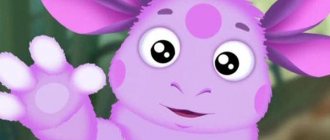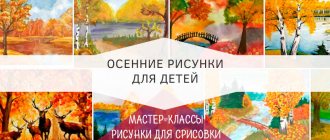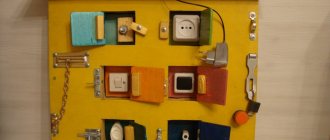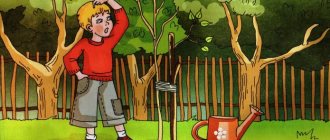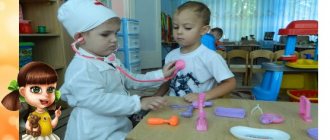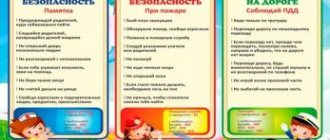Organization of a speech therapy corner in a group of combined and compensatory orientation
The effectiveness of correctional and developmental work with children with SLD largely depends on the interaction between the speech therapist and other specialists. And, above all, speech therapists and educators. In the evening, teachers consolidate the skills acquired by children on the instructions of the speech therapist. In order for correctional work to be successful, this must be done and not only the speech therapist is responsible for correctional work, the main assistants are educators and parents.
The teacher-speech therapist interacts with teachers in various forms: consultations, conversations, interaction notebook/
The teacher conducts classes in the speech therapy corner in the afternoon on the instructions of the speech therapist. Children, together with the teacher, do articulation and breathing exercises. Children practice articulation of sounds and automation in words using object pictures. Sentences and short stories are made up with these words, and games are made to differentiate the given sounds. Work is underway to expand vocabulary, grammatical structure and coherent speech. To carry out high-quality work, it is necessary that the speech corners be filled with practical material and function!
The speech corner in the group should include the following sections:
- articulatory motor skills : (mirror, card index, pictures for articulation exercises, sets of exercises for certain groups of sounds).
- automation of sounds : albums on automation of sounds V.V. Konovalenko, S.V. Konovalenko; game exercises L.A. Komarova; didactic manuals Spivak, Egorova, tongue twisters, card indexes.
- breathing : card indexes, turntables, pipes, balloons for inflation, bubbles, soap bubbles, pillows, exercise equipment for breathing development, disposable straws, games with water (grow foam, storm in a glass, boats), football with an air stream, “snake tongue” and so on.;
- phonemic hearing : musical toys, noisy boxes, card index of games.
- vocabulary : pictures reflecting the lexical topic being studied (plot and subject); educational puzzles, games: lotto, “Pick a Pair”, “Who Can Name More”, “Part and Whole”, children’s “Professions”, “all year round”, “family”, “trees”, etc.; game file.
- grammatical structure of speech : didactic manuals by N.E. Teremkova, N.S. Ruslanova, Z. Agranovich, Kosinova E.M., card index of games
- coherent speech : plot pictures, diagrams of descriptive stories, series of pictures, mnemonics, texts for retelling, Arbekova’s manuals by age
- literacy : word diagrams, sentence diagrams, a manual for sound analysis of words, traffic lights, simple puzzles, isographs, etc. manual by Z. Agranovich
- fine motor skills : small toys, tops, lacing, mosaics, puzzles, stencils for shading, internal and external tracing, pencils, etc.;
- higher mental functions : cut pictures, dominoes, “The fourth odd one”, “Color and shape”, “Recognize by contour”, etc...
I wish you success!
Zaitseva Lyubov Viktorovna teacher-speech therapist, MODU "Kindergarten No. 211", Yaroslavl
Transcript
1 “Organization of a speech corner in a group of preschool educational institutions.” Prepared by teacher-speech therapist Tatyana Nikolaevna Snitko MADOU “D/s 278”, Perm
2 One of the leading tasks that preschool educational institutions solve is the development of children's speech. The solution to this problem involves the creation of speech corners in preschool groups. Speech corners should be located in places accessible to children, decorated brightly, beautifully, aesthetically and neatly. When organizing speech centers, teachers should take into account: the variety of materials, age and individual characteristics of children, accessibility and aesthetics of design. The selection of gaming and didactic material for the speech corner was carried out by teachers and parents jointly. Contents of speech corners in groups. In each age group, a catalog of material located in the speech corner is compiled according to the following scheme: 2nd junior group. The speech corner is based on gaming and didactic material aimed at: developing breathing and air flow; development of articulation and correct sound pronunciation; development of speech hearing; expansion and activation of the dictionary; development of grammatical structure of speech; development of coherent speech; development of fine motor skills of the hands in the process of various types of children's activities. 1. Pictures on lexical topics. 2. Card index: a) on the sound culture of speech; b) articulatory gymnastics exercises; c) breathing exercises; d) finger gymnastics. 3. Works of art according to the program, etc. 4. Verbal didactic games. 5. Pure sayings, poems, nursery rhymes, sayings, sentences. 6. Subject and plot pictures for compiling descriptive stories 7. Various types of theaters. 8. Pictures: - depicting the characteristic features of the seasons; - household items; - details of objects; - depicting the work of adults (the cook cooks, the nanny cleans, the mother sews); - with an image of the size, color, quality of objects; - depicting actions (going to bed, sitting down, getting dressed, walking, sweeping, washing, ironing, etc.). — sets of pictures for grouping, up to 4-6 in each group: domestic animals, wild animals, animals with cubs, birds, fish, trees, flowers, vegetables, fruits, food, clothing, dishes, furniture, transport, household items; — sets of subject pictures for sequential grouping according to various characteristics (purpose, etc.); - a series of 3-4 pictures to establish the sequence of events (fairy tales, social situations); — a series of 4 pictures: parts of the day (activities of people in the immediate environment); — a series of 4 pictures: seasons (nature and seasonal activities of people);
3 - large format plot pictures (with various themes close to the child - fairy tales, social everyday life). Middle group. The speech corner is based on gaming and didactic material aimed at: developing breathing and air flow; development of articulation and correct sound pronunciation; development of phonemic hearing; expansion and activation of the dictionary; development of grammatical structure of speech; development of coherent speech; development of fine motor skills of the hands in the process of various types of children's activities. 1. Pictures on lexical topics. 2. Catalog of games: a) on the sound culture of speech; b) articulatory gymnastics exercises; c) breathing exercises; d) finger gymnastics. 3. Works of art according to the program, etc. 4. Verbal didactic games. 5. Pure sayings, poems, nursery rhymes, sayings, sentences. 6. Subject and plot pictures for composing descriptive stories. 7. Various types of theaters. 8. Pictures: a) depicting natural phenomena; b) household items; c) the main parts of objects; d) depicting the work of adults (the cook cooks, the nanny cleans, the mother sews); e) depicting the size, color, quality of objects (red, etc., clean - dirty, sweet-bitter, big-small, etc.); f) depicting actions (going to bed, sitting down, getting dressed, walking, sweeping, washing, ironing, etc.); e) with images of objects in the plural (one table is many tables, one doll is many dolls); g) to coordinate nouns with numerals (1 pear, 2 pears, 5 pears). 9. Mirror or customized mirrors. Approximate sets of pictures, cards, cubes. 1. Sets of pictures for grouping and generalization (up to 8-10 in each group): animals, birds, fish, insects, plants, food, clothing, furniture, buildings, transport, professions, household items, etc. 2. Sets of pairs “lotto” type pictures from 6-8 parts. 3. Sets of paired pictures for correlation (comparison): find differences (in appearance), errors (in meaning). 4. Sets of tablets and cards for comparison by 1-2 characteristics (logical tables). 5. Sets of subject pictures for grouping according to different characteristics (2-3) sequentially or simultaneously (purpose, color, size). 6. A series of pictures (4-6 each) to establish the sequence of events (fairy tales, social situations, literary plots). 7. Series of pictures “Seasons” (seasonal phenomena and human activities). 8. Scene pictures with different themes, large and small format. 9. Cut (folding) cubes with plot pictures (6-8 parts). 10. Cut-out plot pictures (6-8 parts). 11. Cut contour pictures (4-6 parts). 12. Set of cubes with letters. 13. A set of cards with an image of an item and its name.
4 Senior group. The speech corner is based on gaming and didactic material aimed at: developing breathing and air flow; development of articulation and correct sound pronunciation; development of phonemic hearing; expansion and activation of the dictionary; development of grammatical structure of speech; development of coherent speech; development of fine motor skills of the hands in the process of various types of children's activities. 1. Pictures on lexical topics. For example, vegetables, fruits, trees, shrubs, domestic animals and birds, wintering and migratory birds, wild animals, animals of hot countries, animals of the North, my city, my country, Defender of the Fatherland Day, traffic rules, seasons, insects, household technology, transport, dishes, flowers, professions, berries, mushrooms, space, inhabitants of reservoirs and others. 2. Catalog of games: a) on the sound culture of speech; b) articulatory gymnastics exercises; c) breathing exercises; d) finger gymnastics; e) games for the development of phonemic hearing (color designations of sounds). 3. Works of art according to the program, etc. 4. Verbal didactic games. 5. Pure sayings, poems, nursery rhymes, sayings, sentences, proverbs. 6. Subject, subject pictures, series of subject pictures for composing stories. 7. Pictures: a) depicting natural phenomena; b) pictures depicting professions (bricklayer, painter, carpenter, livestock breeder, agricultural workers, cutter, seamstress, military man, doctor, teacher; c) main parts of objects, for example, transport (cabin, steering wheel, windows, doors, wheels) ; d) depicting special-purpose equipment (crane, excavator, tractor, panel carrier, snow blower), electrical equipment (vacuum cleaner, vegetable cutter, electric meat grinder, mixer); e) with clearly defined characteristics of objects (light, dark, sweet, sour, bitter, sonorous, clean, dirty, durable, fragile, large, etc.); f) depicting actions (going to bed, sitting down, getting dressed, walking, sweeping, washing, ironing, etc.); g) with images of synonyms, antonyms, paronyms, homonyms; h) with images of animals in the plural; i) depicting objects in the plural (1 pear, 2 pears, 5 pears); j) with the image of indeclinable nouns (coffee, coat, piano, cocoa) 8. Mirror or individual mirrors. 9. different types of theaters. Preparatory group. The speech corner is based on gaming and didactic material aimed at: developing articulation and correct sound pronunciation; development of breathing and air flow; development of phonemic hearing, development of intonation expressiveness of speech;
5 expansion and activation of the dictionary; development of grammatical structure of speech; development of coherent speech; development of spatial concepts; expanding the ability to navigate in the plane of a sheet and in various lines; preparing the hand for writing in the process of various types of children's activities. 1. Pictures on lexical topics. For example: vegetables, fruits, trees, shrubs, domestic animals and birds, wintering and migratory birds, wild animals, animals of hot countries, animals of the North, my city, my country, Defender of the Fatherland Day, traffic rules, seasons, insects, household items technology, transport, dishes, flowers, professions, berries, mushrooms, space, inhabitants of reservoirs and others; 2. Catalog of games: a) on the sound culture of speech; b) articulatory gymnastics exercises; c) breathing exercises; d) finger gymnastics; e) games for the development of phonemic hearing (color designations of sounds). 3. Works of art according to the program, etc. 4. Verbal didactic games. 5. Pure sayings, poems, nursery rhymes, sayings, sentences, proverbs. 6. Story pictures, series of story pictures for composing stories, games for the development of coherent speech, subject pictures for composing a descriptive story based on a diagram; 7. Pictures: a) depicting natural phenomena; b) pictures depicting professions (bricklayer, painter, carpenter, livestock breeder, agricultural workers, cutter, seamstress, military man, doctor, teacher, etc.); c) main parts of objects, for example: transport (cabin, steering wheel, windows, doors, wheels); d) depicting special-purpose equipment (crane, excavator, tractor, panel carrier, snow blower), electrical equipment (vacuum cleaner, vegetable cutter, electric meat grinder, mixer); e) with clearly defined characteristics of objects (light, dark, sweet, sour, bitter, sonorous, clean, dirty, durable, fragile, large, etc.); f) depicting actions (going to bed, sitting down, getting dressed, walking, sweeping, washing, ironing, etc.); g) with images of synonyms, antonyms, paronyms, homonyms; 8. Mirror or customized mirrors. 9.various types of theaters. The speech corner may contain such aids as: 1. Aids for teaching correct physiological breathing (simulators, “Soap bubbles”, inflatable toys). 2. Materials for sound and syllabic analysis and synthesis, analysis and synthesis of sentences (multi-colored chips or magnets). 3. Games to improve language analysis skills (for example, “Syllable Lotto”, “Locate the place of the sound”, “Choose words”, “Chain of sounds”, etc.). 4. Games to improve the grammatical structure of speech. For example: “Call it affectionately”, “One-many, many-one”, “Make a word out of two”, “Add a word”. 5. Clarification, enrichment and activation of vocabulary.
6 Nr: “Call the animals the ball”, “Who is doing what”, “Hot cold”. When working with children of senior preschool age, special attention is paid, in addition, to the availability of manuals and demonstration materials for preparing children for learning to read and write. These can be: - cool mobile alphabet, - alphabet in pictures, - didactic games, - sound rulers, - a set of letters of different colors, sizes, materials, - didactic material for depicting letters (ropes, pebbles, etc.), - blanks for shading , stencils, punched cards for preparing your hand for writing, games to develop manual skills. In our kindergarten groups, speech centers have been established for the full speech development of children.
7
8
